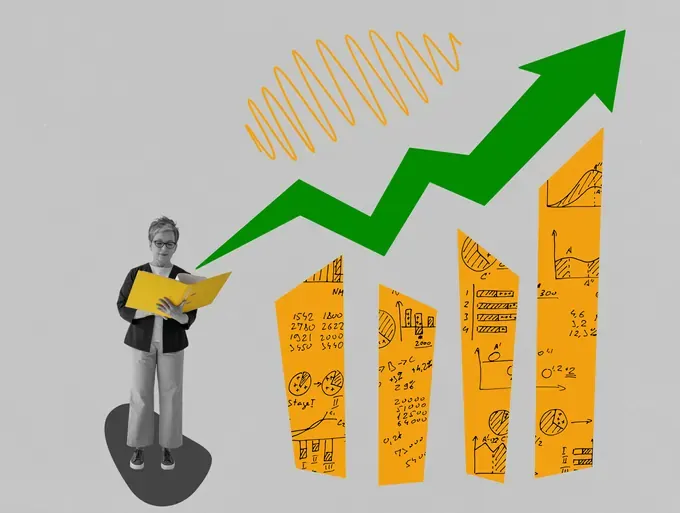

In a world where economic certainty is as fleeting as the latest trend, and in an art landscape historically resistant to change particularly in the realm of e-commerce, contemporary art is proving a surprising bastion of resilience.
Offering both aesthetic pleasure and a shrewd investment, contemporary art has not only sustained but thrived with a full embrace of digital transformation. A Hiscox Online Art Trade Report* marks this seismic shift up to 2020; while merely 7.5% of global art sales were online in 2019, the pandemic catalysed a digital revolution.
The report follows: before the global pandemic online art sales nearly doubled to 15.8% and a later Hiscox report showed it continued to climb to the point that, by early 2022, almost two-thirds of art buyers had made purchases online.
This is no surprise to beneficiaries of the pump: despite ups and downs in other markets, the value of contemporary art has shown remarkable tenacity.
A shift to digital platforms has not only broadened global reach for contemporary art; it’s enriched buyer knowledge because information is so accessible and pricing is more transparent than ever before. The new generation of collectors are tech-savvy and in many cases, digitally native; industry insiders are not shocked that Christie’s and Sotheby’s reported staggering increases in online sales of 120% and 413% respectively in 2020.*
Maddox Gallery’s 2022 report* further cements this narrative, highlighting an impressive 27.9% increase in the value of works by select contemporary artists. Such heady numbers underscore the investment appeal of contemporary art which now often outpaces traditional stocks and bonds.
The market’s dynamic evolution is certainly legitimised by the steadily rising value of contemporary art. Esteemed British sculptor Steve Winterburn is a testament to the trend: his dynamic silver and bronze pieces are not just captivating, earning him a British hallmark — they’re lucrative, in part due to his astute use of digital galleries and social media to tap into the global market.
The Ethical Collector’s Influence
But what drives this collectibility? It appears the younger generation is turning to art collecting not just for aesthetic or financial reasons, but for ethical ones too.
This was a growing trend revealed by the Deloitte Art & Finance Report* 2021: a cohort of new collectors is marrying the emotional allure of art with a keen focus on its financial potential and social impact, with a striking 86% of collectors under 35 ranking purpose-led investments as a primary motivation for acquiring art — a sentiment shared by only 32% of older collectors.
Additionally, sustainable impact investment in the arts is emerging as a favoured model, especially among young collectors, half of whom view it as the most attractive investment approach which suggests a significant alignment of art investment with broader environmental, social, and governance (ESG) goals. This convergence of art, finance, and ethics indicates a robust future for art within the values-driven priorities of the younger generation.
There are notions ESG is taken seriously by leaders in the art world, too. Iwan Wirth is the co-founder of Hauser & Wirth, one of the world’s leading contemporary art galleries, and he’s been involved in various initiatives and discussions around art, culture, and sustainability.
Iwan Wirth has been on record saying: “The scale of the challenges facing all of us will require both immediate action and long-term commitment… it’s a global citizenship issue that reaches beyond the art world.”
Steve Winterburn is an example of an artist linking the worlds of sustainability and art together in its purest form: he’s been hands-on in conservation efforts, even working with national treasure David Attenborough at one point, and is a patron and trustee of ThinkOcean. He’s also a trustee of the Big Cat Sanctuary, giving them a slice of the profits from his series of sculptures capturing the image of our cherished big cats. Winterburn’s latest bronze collection, ‘Timeless’, further emphasises the beauty and power of endangered species.
Other British artists marking this shift include Birmingham-born John Newling who has been long esteemed for a profound integration of nature into his art. The relationship between the natural world and human societies see him frequently use plants and organic materials as primary elements in his installations and sculptures. It’s not uncommon to see Newling employ recycled materials either with a focus on the regenerative processes of nature.
And there is no secret about the man making waves called Banksy, despite utter secrecy around his identity, with the enigmatic street artist’s work often selling for millions at auction. With a global following and pieces that comment on social and political issues, Banksy’s art is the epitome of a cause that resonates with the socially conscious collector.
But for artists like Newling and Steve Winterburn, the latter known most recently in the national psyche for Wembley Stadium’s ‘Rugby Legends’ bronze statue, the focus isn’t always explicitly preserving the natural world — the materials they use should either go back into the ecosystem, as is the case for John Newling, or in Steve’s case: never perish.
Visionary Artists and the Digital Leap
Winterburn’s sculptures, often depicting powerful animal forms, have furthermore seen time-tested appreciation in value thanks to their emotive power and the narrative they carry. “Art is not just an object of momentary desire but a legacy that endures, gaining in value and relevance with each passing year,” Winterburn shares.
Richard Carr, MD of Carrs Silver of Sheffield, emphasises the intrinsic value of the materials in art, “Our collaboration with Steve Winterburn on limited edition pieces has proven to be a wise investment. The precious metals alone carry worth that appreciates over time, but when combined with Steve’s vision, the value multiplies.”
The digital transformation of the art market has certainly played a role. Digital art fans will note online-first artist Michael Joseph Winkelmann, better known as Beeple, who smashed records with a $69 million sale at Christie’s of a digital collage entitled ‘Everydays: The First 5000 Days”. Members of the media and traditional art world were confounded by the rock star welcome for Beeple at his first gallery show in New York, with queues around the block and celebrities like Jimmy Fallon turning up.
The truth is that platforms have democratised access to contemporary art, broadening its appeal and inviting a younger demographic to the collecting table. Winterburn’s savvy use of social media and digital galleries, for example, has amplified the visibility of his sculptures, attracting a global audience and elevating the value of his work.
Timeless Allure of the Traditional
But while the digital art scene, exemplified by trailblazers like Beeple, has undeniably transformed the landscape of contemporary art, the enduring allure and skill inherent in traditional art forms is self-evident. The tactile nature of traditional art crafted through time-honoured techniques holds a tangible connection to reality that cannot be fully replicated in the digital realm.
Artists like Steve Winterburn, whose mastery in sculpting materials like bronze and silver into lifelike forms, remind us of the depth and complexity involved in traditional artistry. The physical act of creation, the manipulation of raw materials into a work of art, carries with it a sense of authenticity and a palpable connection to the human experience. This connection is often felt in the weight of a sculpture, the texture of a painting, or the intricate detail of a hand-drawn illustration — elements that ground these works in a reality that is both felt and seen.
The digital transformation, while revolutionary, acts as a complement to traditional art rather than a replacement. It opens new doors and expands horizons but it also brings into sharper focus the unique qualities of traditional artistic techniques. The skill, time, and physical presence imbued in these works create an irreplaceable experience that continues to resonate deeply with audiences. In a world increasingly oriented towards the virtual, the enduring appeal of traditional art highlights our immanent desire for tangible connections and the timeless value of craftsmanship grounded in reality.
Contemporary art stands as a testament to the power of creativity and the enduring appeal of wise investments. While contemporary artists lead the charge with new techniques and stratagems, it’s the youth that are loosening the purse strings for art investments they can take on in good conscience. It’s evident that art is more than just a cultural touchstone; it’s a viable and resilient investment, capable of weathering economic storms and offering returns that extend beyond the financial.
For those seeking to diversify their portfolio or simply to own a piece of the zeitgeist, the allure of contemporary art is undeniable. In the hands of visionary artists and forward-thinking collectors art becomes more than an asset; it becomes a legacy, imbued with the power to inspire and appreciate across generations.
*
Sources:
https://www.hiscoxgroup.com/news/press-releases/2022/26-04-22
https://www.hiscox.co.uk/online-art-trade-report
https://www.citigroup.com/global/insights/citigps/the-global-art-market-and-covid-19
https://maddoxgallery.com/art-advisory/
https://www2.deloitte.com/lu/en/pages/art-finance/articles/art-finance-report.html


